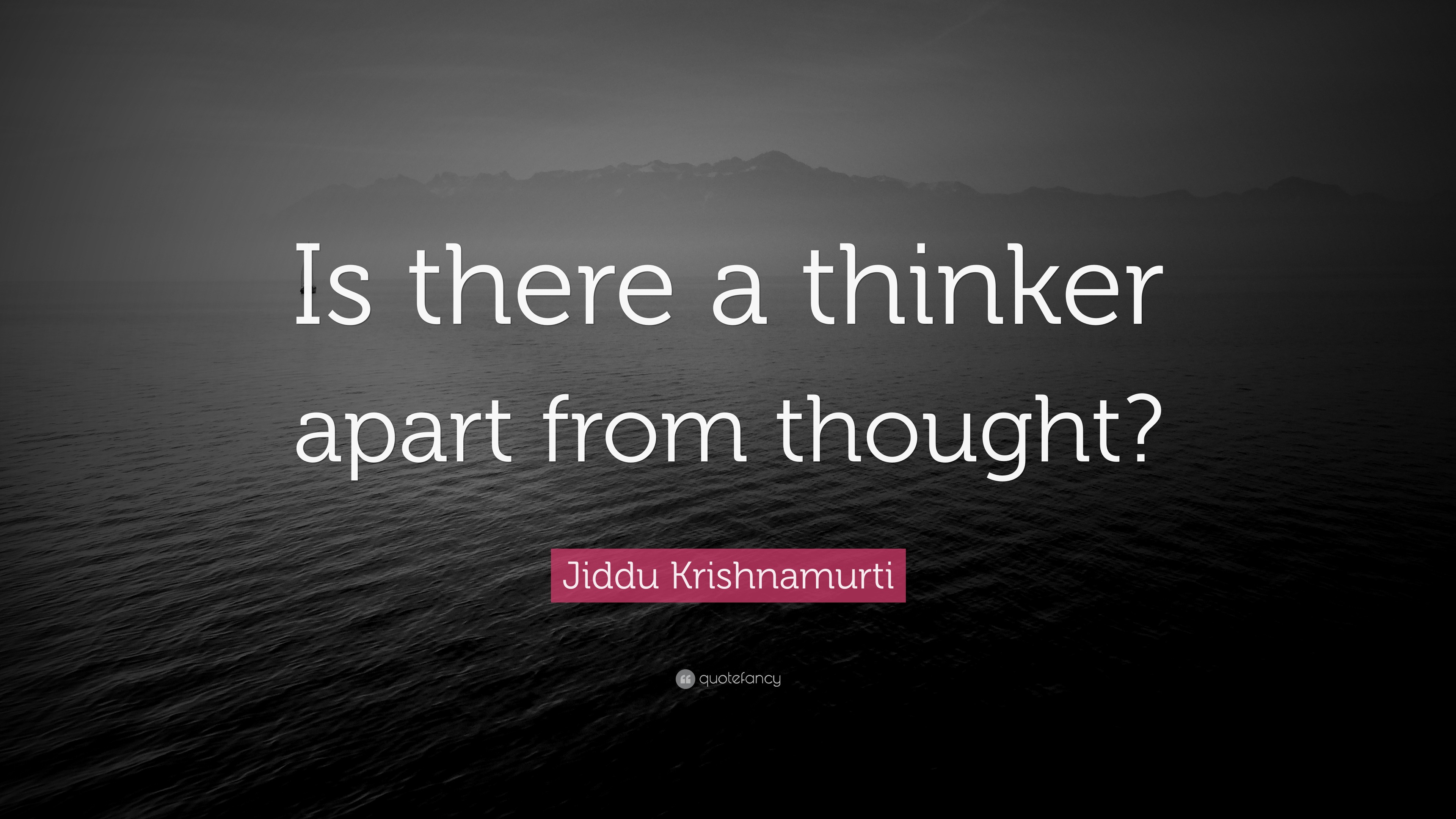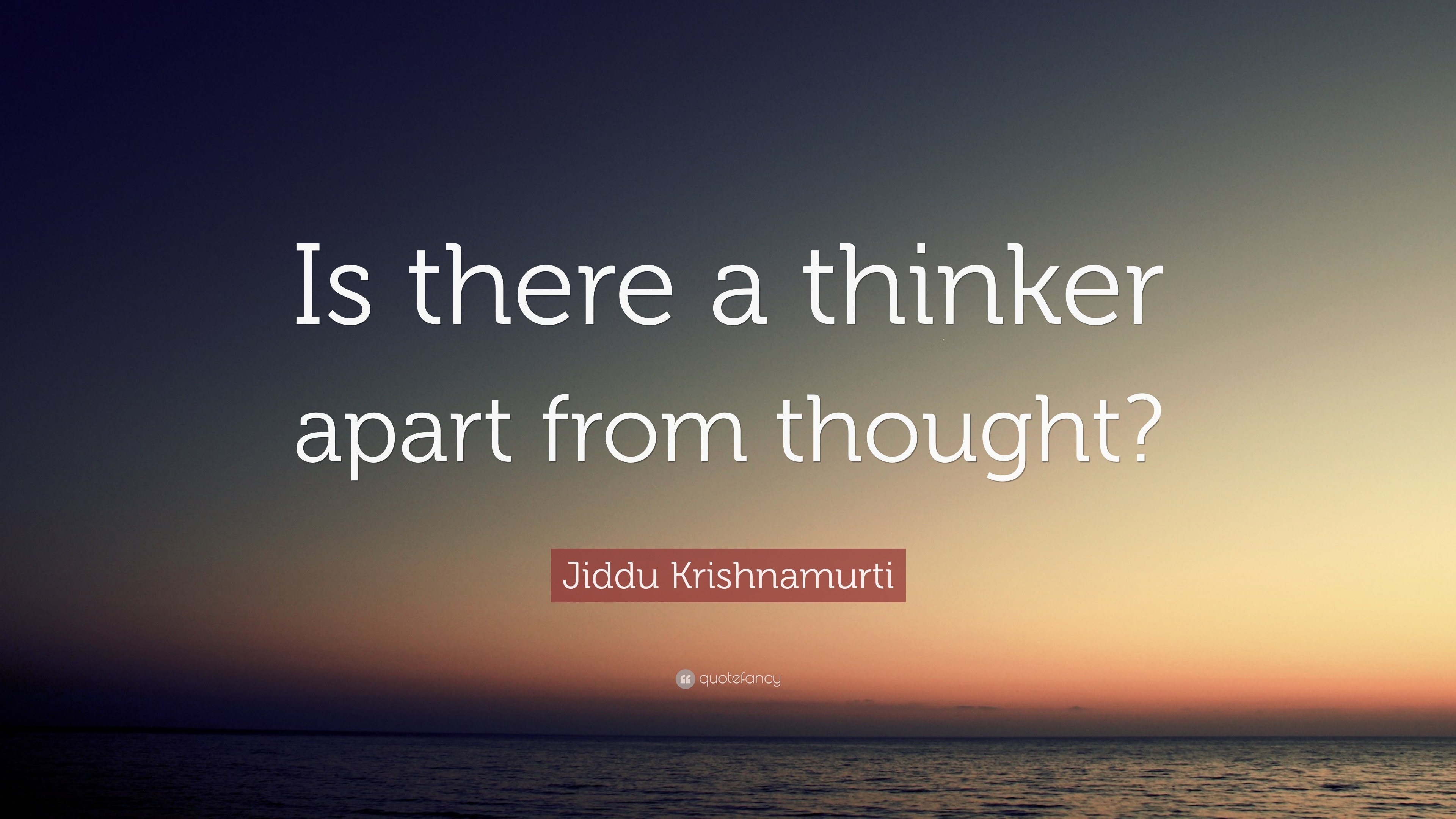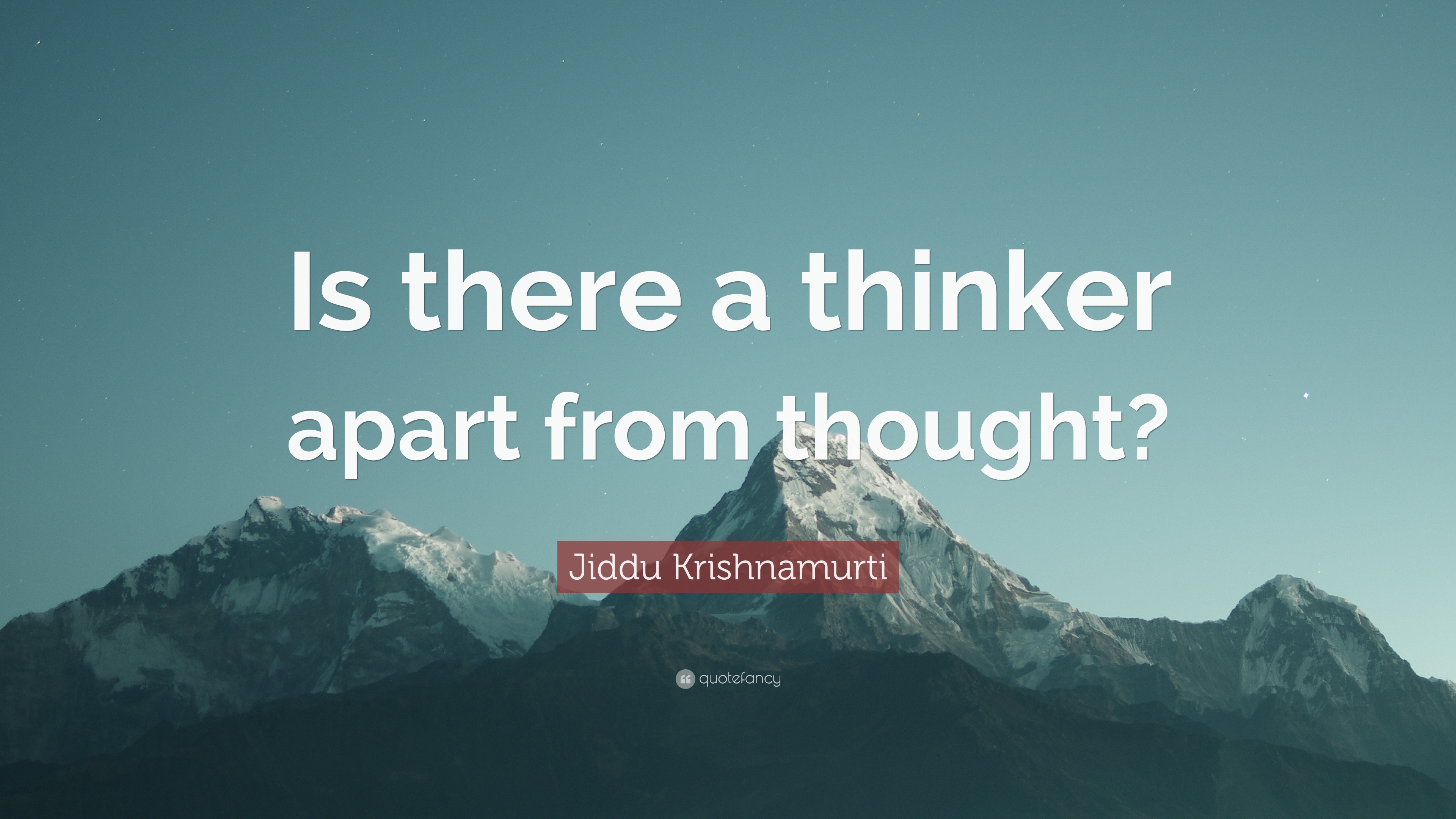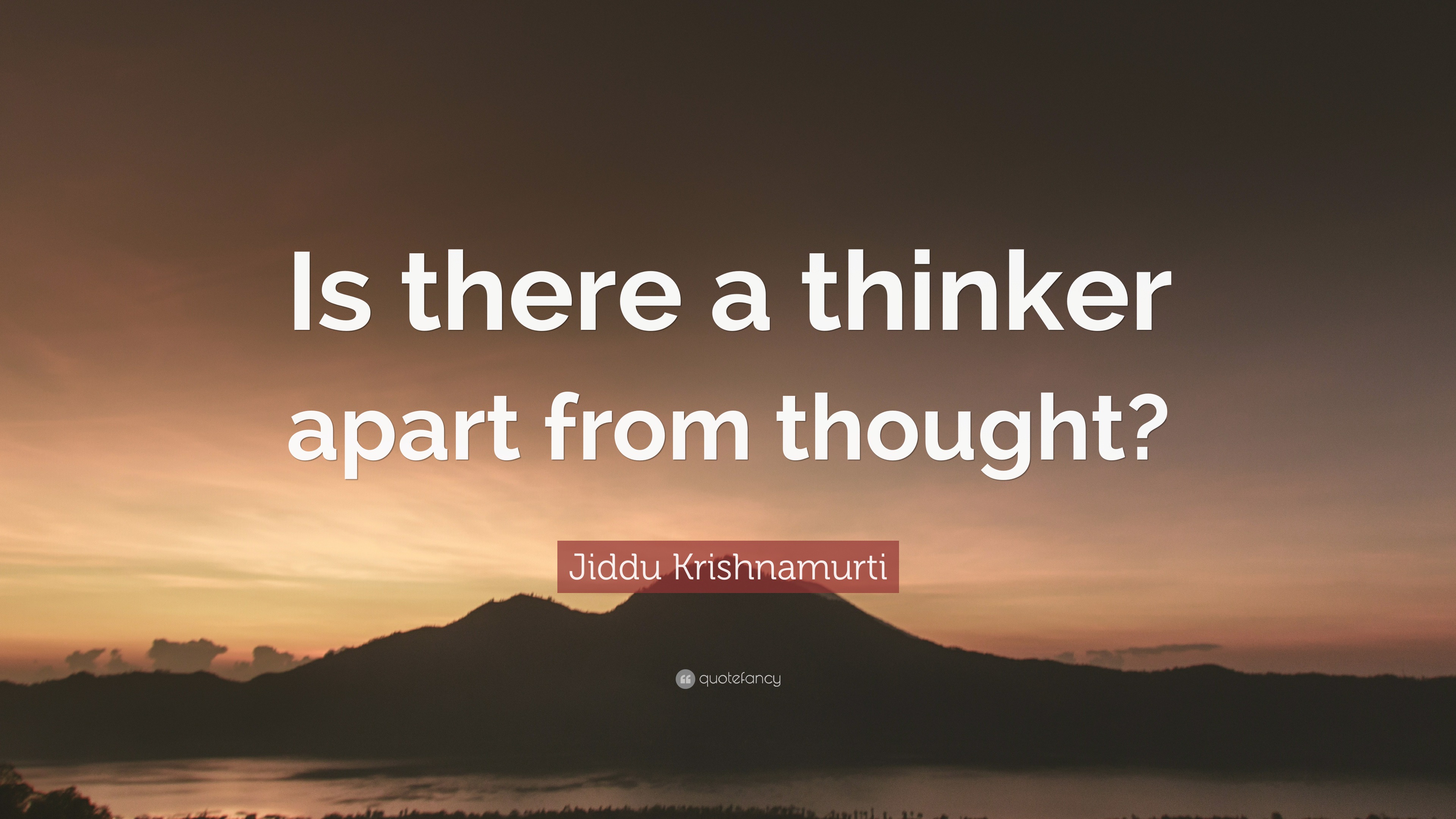j krishnamurti thought creates the thinker
Associated Articles: j krishnamurti thought creates the thinker
Introduction
With enthusiasm, let’s navigate by way of the intriguing matter associated to j krishnamurti thought creates the thinker. Let’s weave fascinating data and provide contemporary views to the readers.
Desk of Content material
Thought Creates the Thinker: Unpacking J. Krishnamurti’s Revolutionary Concept
![[PDF] There is No Thinker Only Thought by J. Krishnamurti eBook Perlego](https://www.perlego.com/books/RM_Books/publish_drive_xfphfcg/thumbnail_9781912875160.jpg)
Jiddu Krishnamurti, a thinker and non secular instructor, provided a radical perspective on the character of thought and its relationship to the self. He did not merely analyze thought; he challenged its very basis, arguing that the "thinker," the perceived entity who experiences and interprets the world, is a assemble of thought itself. This assertion, that thought creates the thinker, is central to his philosophy and has profound implications for understanding consciousness, freedom, and the human situation. This text will delve into this revolutionary thought, exploring its nuances, implications, and enduring relevance.
Krishnamurti’s critique of thought is not a rejection of mental inquiry. As a substitute, it is a meticulous examination of the routine, usually unconscious, processes of the thoughts. He noticed that the majority of our considering is reactive, conditioned by previous experiences, cultural conditioning, and ingrained beliefs. This conditioned considering creates a way of a separate, impartial self – the "thinker" – who is consistently reacting to and deciphering the world. This "thinker" is just not a secure entity however a dynamic course of, continuously shaping and being formed by thought.
The method begins early in life. As kids, we study to categorize and label our experiences, creating psychological fashions of ourselves and the world. These fashions, constructed upon restricted data and sometimes primarily based on concern and insecurity, grow to be the muse of our sense of self. We determine with these psychological constructs, believing them to be the essence of who we’re. This identification results in a way of separateness, a sense of being a person remoted from the remainder of existence. This sense of isolation, Krishnamurti argues, is the foundation of a lot of human struggling.
The "thinker," subsequently, is a product of this steady technique of categorization and identification. It is not a pre-existing entity that observes and interprets the world; it’s the very act of observing and deciphering. It is a assemble constructed upon reminiscence, notion, and perception, continuously reinforcing itself by way of a suggestions loop of thought. This self-perpetuating cycle prevents us from experiencing actuality instantly, unfiltered by the lens of our conditioned thoughts.
Contemplate the straightforward act of seeing a tree. For many of us, the expertise is not merely the notion of the tree itself. Our minds instantly start to categorize and interpret: "That is an oak tree," "It is tall," "Its leaves are inexperienced," "It is lovely." These ideas, arising from previous experiences and discovered associations, overlay the direct sensory expertise, making a psychological picture of the tree slightly than permitting us to understand it purely. The "thinker," on this occasion, is the mechanism that generates these ideas and labels, filtering the uncooked sensory knowledge and shaping our expertise.
Krishnamurti emphasizes the inherent limitations of this thought-based self. The "thinker," constructed on reminiscence and conditioning, is inherently restricted by its previous. It will possibly solely function throughout the framework of its present beliefs and prejudices, stopping it from actually understanding the current second. This limitation results in battle, each inside and exterior. We’re continuously at odds with ourselves and the world, attempting to power actuality to evolve to our pre-conceived notions.
The trail to freedom, in response to Krishnamurti, lies in understanding and transcending this thought-created thinker. It is not a matter of suppressing or controlling thought, however of observing it with out judgment. By turning into conscious of the routine patterns of the thoughts, we will start to see the phantasm of the separate self. This course of requires self-inquiry, a deep and sincere exploration of our personal ideas, emotions, and motivations.
This self-inquiry is just not an mental train; it is a apply of conscious consideration. It includes observing the incessant chatter of the thoughts with out getting caught up in its narratives. It is about witnessing the ideas, emotions, and sensations that come up with out figuring out with them. This technique of commentary progressively dissolves the sense of a separate self, revealing a deeper, extra basic actuality past the constraints of thought.
This deeper actuality is just not simply outlined. Krishnamurti usually used the time period "choiceless consciousness" to explain it. It is a state of being by which we’re totally current, conscious of our expertise with out judgment or interpretation. On this state, the "thinker" ceases to dominate, and we expertise a way of openness, freedom, and interconnectedness.
The implications of Krishnamurti’s insights are profound. If the "thinker" is a assemble of thought, then our sense of self, our identification, is just not mounted or immutable. It is a fluid course of, continuously altering and evolving. This understanding challenges the very basis of our private and social buildings, which are sometimes constructed on mounted notions of self and identification.
By understanding that thought creates the thinker, we will start to query the assumptions and beliefs that form our lives. We are able to problem the narratives we inform ourselves about who we’re and what we’re able to. This self-awareness permits for better flexibility and flexibility, enabling us to answer life’s challenges with better readability and compassion.
The trail to this self-awareness is just not straightforward. It requires braveness, persistence, and a willingness to confront our deepest fears and insecurities. It calls for a relentless vigilance, a steady questioning of our assumptions and beliefs. However the potential rewards are immense: a life lived with better freedom, authenticity, and pleasure.
In conclusion, J. Krishnamurti’s assertion that thought creates the thinker is a robust and transformative thought. It challenges our basic understanding of ourselves and the world, urging us to query the very foundations of our expertise. By understanding this course of, we will start to dismantle the phantasm of the separate self and uncover a deeper actuality past the constraints of thought, a actuality characterised by freedom, peace, and interconnectedness. His work stays an important contribution to philosophical and non secular inquiry, providing a path in direction of self-knowledge and liberation that continues to resonate with seekers right now. The continued relevance of his message lies in its timeless attraction to the human want for understanding, freedom, and a deeper reference to ourselves and the world round us. The journey of self-discovery, as Krishnamurti emphasizes, is a steady technique of self-inquiry, a relentless unfolding of consciousness, main in direction of a life lived within the current, unburdened by the constraints of the thought-created thinker.
![[PDF] There is No Thinker Only Thought by J Krishnamurti 9781912875160](https://img.perlego.com/book-covers/975264/9781912875160_300_450.webp)







Closure
Thus, we hope this text has supplied invaluable insights into j krishnamurti thought creates the thinker. We thanks for taking the time to learn this text. See you in our subsequent article!